- Duane
Leinninger.com
From the field...
For What It's Worth...
December 18th, 2004:
Gina is a doctor!
December 12th, 2004:
Adventures In Home Media Solutions, Part 3
Television viewing and recording was (initally) my top priority. It is a bit ironic that I have not successfully tested this feature for either platform. However, this was about to change. I decided that my BT878 based card just wasn’t going to cut it. Hauppauge has always been the big name in consumer computer-based television and video-in. The selection of PCI pvr (WinTV-PVR) products has grown recently, ranging from the PVR-150 to the massive PVR-500 MCE. There are some important things to understand about the PVR product line. The PVR-250 and PVR-350 have been around for a while. They use an established series of mpeg hardware encoders for realtime compression during recording. The PVR-150 and PVR-500 are newer products. They share the same chipset with each other. The PVR-150, however, does not have a hardware MPEG video decoder. All models have radio tuner capability, except the PVR-500 (because it’s dual-tuner inputs don’t leave enough room for the radio antennae input). The 150, 250, and 350 are available as non-mce versions. This means that they come with a remote… a remote that is not compatible with Windows Media Center Edition. So the MCE-versions all come without remotes, since Windows MCE already has one. The PVR-500 is only available in the MCE version.
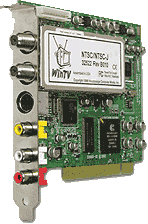
Hauppauge makes some nice gear,
including the PVR 250.
The two most tempting models are the PVR-150 and PVR-500. The former for it’s low price point, and the later for it’s drool-worthy dual tuner capability (record 2 shows at once, or watch a channel while recording another). However, these are currently completely incompatible with MythTV and more specifically, Video 4 Linux. They use a new single-chip hardware configuration. This may change in the future as the PVR-500 becomes more widely used. However support for the PVR-150 may never exist as it lacks a hardware MPEG decoder of any sort. If you want to keep your options open, enabling yourself to switch between Linux and Windows solutions, stay away from the PVR-150 and PVR-500… at least for now. The PVR-350 is not offered as a MCE version, increasing it’s price. Additionally, I could find no inherent performance or feature benefits over the PVR-250. My decision was made, WinTV-PVR-250MCE. (Yeah… that deserves a Type-R as well…)
A few days later and the Tuner was installed. Rather than replace my MCE installation with MythTV, I opted to swap out my hard drive with a spare 20 gb unit. By know, you may be wondering why I didn’t just dual-boot my system. My answer? My final solution would not be in a dual-boot environment. Additionally, I only have a 40 gb drive. There’s no way I could do much with both environments installed on the same drive. Back to my MythTV install. The only major changes I made to the default KnoppMyth install were to my /etc/fstab file (to automount my video and music shares) and to the /etc/X11/XF86Config file (for X resolution, overscan, color depth, etc.). I backed them up to a network drive and was able to re-use them for this re-install. Once again, I tried to view network videos… still no luck. Perhaps I could have solved this with a few mplayer command line tweaks. I didn’t have the patience or concentration to deal with that at the moment. On to the TV. I was able to download the latest tv listings and flip through a few stations. The interface is quite nice; a little more interesting than MCE, but a little more dated at the same time. Responsiveness is good, but there is a slight lag when flipping channels, something that I did not notice in MCE. All of the other features are on par with their MCE counterparts. In short, TV viewing and recording are excellent using MythTV. The guide and viewer are mature and bug-free. So far this is the most developed feature in this environment. I am officially impressed.
Back to Windows XP Media Center Edition 2005 (Type-R Sti J-Spec Turbo GT). The tuner setup process is a breeze, it detects your tv signal type and uses your locale and zip code to locate the correct tv listings for your area. The signal types are: Antennae, Cable, and Set Top Box (Satellite, Digital Cable)… that last one caught my attention. Currently, I’ve connected my Media PC directly to the cable line with a simple 2-way splitter (the other end connects to my digital cable box). After checking out the connections on the back of my cable box, I noticed an unused “Out to TV” coaxial connection (I’m using s-video out for my cable box to tv connection). So, I removed the splitter, hooked the cable line directly to my cable box, and my Hauppauge card directly to the “Out to TV” connection on the cable box. I re-ran the tuner configuration wizard in MCE and it detected the set top box signal! However, it informed me that the IR hardware required to control the set top box was not installed, and could not continue. My remote arrived a few days later. I simply plugged it in, and it worked. The Media Center controlled my cable box using 1 of the 2 “IR blasters” attached the the ir receiver. This enabled full Media Center interaction with all of my available cable channels, digital included. While there is a split-second lag between button press and channel change (due to this man-in-the-middle kind of interface), it is mostly transparent.
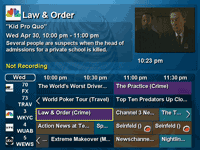
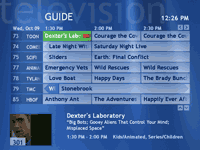
MythTV’s guide (left) is slightly more attractive than XP Media Center Edition (right)… at least in my opinion, but both are feature rich and responsive.
Compared side-by-side MythTV and MCE’s television playback and recording features are very similar. Both offer an intuitive interface that allows on-the-fly and scheduled recording with a few keypresses. Both interfaces are snappy, though the set top box control that I decided to use with MCE does have a barely noticable delay. I did not find a similar way to integrate my cable box with MythTV. According to their respective websites, both solutions offer dual-tuner support. This would allow one to record one channel and watch another, or record 2 different channels simultaneously. Now that I am using my cable box as a tuner source, I can see the need for such a feature.
In the final installment of this article, I will summarize my findings, list the components I investigated and selected (with the reasons for said decisions), and deliver my opinion on which solutions fit which users. I never got around to trying out the solutions offered by SnapStream, but I may still do so at some time in the future. Stay tuned…
- Duane
December 12th, 2004:
Home Media Center Part 3 is here! Return of the Newton.
Part 3 of the MythTV vs. XP MCE is up. This part focuses on the TV/PVR features of each solution. I should mention that I never personally evaluated Tivo. I am sure that it is a great solution for many folks. A subscription is not required, but adds some important features… but there are many ways to work around the subscription. I already had the hardware (for the most part), and I wanted to browse the web and play some games… so Tivo wouldn’t cut it for me.
Once again, I’ve dug out my Newton and am trying to justify uses for it. It is still, by far, the best PDA I’ve ever owned. (I’ve had 3 Palm Pilots and a PocketPC.) It’s handwriting recognition is stellar, and it’s interface is intuitive and quick. It’s just to damn huge. I’ve destroyed jacket pockets carrying this thing around. Please, Apple, release a new device that his smaller and lighter with a big screen. For now, I’ll continue to telnet and email from my beloved Newton while I carry out all other personal organization with my Palm Zire. (I’m a sell-out.)
- Duane
December 7th, 2004:
Adventures In Home Media Solutions, Part 2
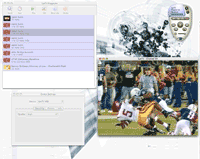
EyeTV by El Gato provides flexible
TV recording and viewing options.
I like Macs. A lot. My first Mac was the result of a direct need to use the computer that graphics professionals were using the real world. Within a week of my first startup chime I was hooked. It was intuitive, reliable, and dare I say… fun?! I would have loved to build a Mac-based solution, but the current offerings are expensive. The only consumer-ready integrated media solution is eyehome (once again from El Gato Systems). This appliance uses your existing Mac and an EyeTV interface via a network connection to view recorded telivision, listen to music, watch videos and photo slideshows, and browse the web. My main complaint is not resolved by this solution, the only TV listing solutions available are web-based… and you can’t access the tv recording features directly from eyehome… you still have to run to your Mac to start or schedule a recording. Since this solution still uses my main computer, requires an EyeTV in addition to the eyehome appliance, it’s simply too complicated and expensive to consider… and I really want an onscreen guide to browse tv shows and schedule recordings!
The options I would consider were:
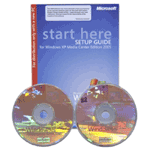
Windows XP Media
Center Edition 2005
Microsoft’s new “Windows XP Media Center Edition 2005“. Personally, I would have like to see a Type-R tacked onto that bloated handle. (What the hell? They couldn’t decide which naming standard to go with? Make up your mind Bill… stick to editions (ME, NT, XP), versions (3.11), or years (95, 98, 2004). Don’t try to cram them all onto the box!)
SnapStream’s Beyond TV for Windows, an application for recording and viewing television that can be controlled via remote.
MythTV or more accurately KnoppMyth which offers a “simplified” Linux installation and hardware detection process… more on that later.
I began to investigate these options on my existing “theater” PC. An aging Windows XP machine connected to my home theater system. It consists of a 1.1 ghz Athlon, 256 megs of RAM, ATI 7500 video card, the aforementioned BT878 tuner card, and a lowly 40 gb hard drive. I admit, I was being incredibly optimistic. But, I figured I would try to get this working with as little investment as possible.
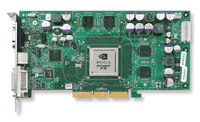
NVidia’s GeForce FX
I first tried to install XPMCE2005(Type-R) on top of my existing XP Pro environment despite dozens of online rants against such a folly. After 2 tries, I decided that this would indeed call for a reload. But, rather than try XPMCE2005(Type-R STi) from the get-go, I went with my gut instinct and installed KnoppMyth… sort of. The instructions offered were simple and straight-forward. The actual process, was, unsurprisingly, not. Ideally, the live cd (once burned) should boot up, detect all of my hardware, prompt me for a few simple settings, and install itself. Easy enough… but, don’t let the system go to sleep while installing. It locks up. Hardcore. Keep tapping a control key to avoid sleep at all costs.
Once that obstacle was overcome, the installation completed and prompted me for a reboot. It successfully restarted, went through the usual Linux initialization scripts and started X… technically. I was greeted with an obviously out-of-sync television display. I know there must have been something really cool to see, but damned if I could. I immediately Control-Alt-F1’ed to the console, logged in, and began poking through the XF86Config file (which controls many settings for the behavior of the X sessions display including vertical and horizontal sync, color depth, resolution, ad nauseam). An our later and I resorted to the MythTV web forums for support. Plain and simple, ATI’s Linux support was mediocre at best. God help you if you wanted to use the TV-out functionality of the video card. Strike 1… and I have a feeling there’s going to me more than 3 strikes total in this game.
Since that attempt was now null and void, why not try XPMCE2005(Type-R STi J-Spec)? This is the first Windows installation that requires 2 CDs. (Why not just use a single DVD, Bill?) This installation was as straightforward as Windows gets. Browsing the License Agreement(s) took more mouse clicks than the rest of the installation, but about 40 minutes later, XPMCE2005(Type-R STi J-Spec Turbo) was installed. My first reaction was indifference. It looked like regular old XP with a slightly updated (simplified) theme. I clicked into the start menu to find an unfamiliar icon for the Media Center. That’s when it happened. I would have been no less surprised if the sound of an Autobot transforming erupted from my speakers. I was no longer looking at a keyboard-and-mouse-navigated desktop, but a simplified, appliance-like interface that was both feature-rich, and incredibly simple. Even my parents would more likely be confused by a DVD menu than this! Immediately I headed for the settings. (The TV option wasn’t available to my chagrin.) Here’s where things started to go awry. A message appears notifying me… nay… taunting me with the fact that my video card was not compatible with Media Center. I was a little surprised by this, but after a quick visit microsoft.com, I confirmed that a DirectX 9-compatible card was required. It was official, my first required upgrade is a video card. While researching this, I also discovered that my 1.1 ghz Athlon was not up to par, either. While this hardware may still work with MythTV, there was a good chance that it would not be beefy enough to handle recording live tv.
Even though my video card was shunned by the Media Center, I was allowed to click around. I continued to the tv settings and found that my tuner card was also incompatible. Bah. Time to stop and evaluate my options.
Both MythTV and MCE would require a new video card. MythTV was more friendly with the Nvidia offerings than those from ATI. MythTV appeared to recognize my tuner during the boot sequence, but I was unable to test this without getting all of the way into the interface. There was a good chance that I would need to power-up in the hardware department. 1 ghz just wasn’t going to cut it.
After some research, I decided that Nvidia’s budget-minded GeForceFX 5200 was the route to take. I could replace my motherboard and processor inexpensively. After a few hardware swaps with friends and a delivery from my hero, the UPS guy, I was ready to try again. The updated specs? Athlon 2600+, 266 fsb, 726 megs of RAM. Would you like fries with that?
Back to MythTV. I was becoming an old pro at this installation stuff. I got the installation down to about 20 minutes. I booted into X (yay!), hopped out of the gui, made changes via the console to the XF86Config file, and I was in business. Kinda. The instructions stated that I should run a command-line installer to get the Nvidia drivers installed and the processor-specific apps installed. A few days had passed since my last swing at this, so I had forgotten about this completely. Fast forward a bit, I had had righted my wrongs. (BTW – the folks on the discussion boards weren’t kidding about the advanced Nvidia support. From overscan to refresh rate and video acceleration, you can tweak it in the XF86Config file.)
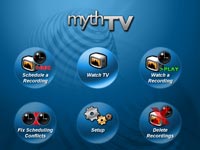
MythTV’s Refined User Interface
My vigilance was rewarded with the most polished Linux interface I have yet encountered. Smooth screen transitions and easy-to-use navigation ooze from the MythTV GUI. Heading straight for the TV settings, I was once again informed that my card was incompatible. (Actually, it said that it was already in use and recording a program. Which universe this was occurring in was unknown to me. So, let’s assume it meant to say that my card was just plain crap.) Fine, I could probably fudge with the config files and get it to work. A few years ago, I had proven that I could use this tuner with Video 4 Linux… I also remember what a horrendous pain the arse it was. Not yet ready to dive into such an endeavor, I decided to mount my shared video directory from my home control server. Easy enough. The video all appeared in the user interface. A double click later and all I get for my effort was a 1/2 second loading screen, then nothing. Nice. Undeterred, I then mounted my music and played a few MP3s. Finally, success! I checked out a few of the additional features offered by MythTV which included an impressive weather plug-in and a (very) simple RSS aggregator. The GUI occasionally locked, but could be restarted with some command line magic. It should be noted that MythTV is controlled exclusively via keyboard/remote. There is no mouse support at all. Personally, I didn’t like this, especially when it came time to make my mp3 playlists. However, others may be indifferent to this “feature” Time to see what Chairman Bill could do for me.
I admit I felt a little dirty when I began re-installing Windows. MythTV was so close to what I wanted… I reminded myself to remain neutral until I had evaluated my options fully. Once again Windows was installed and I was back into the Media Center. This time there was no warning regarding my video card. However, there was still no TV tuner goodness. (I noted that even though I had doubled the processor mhz and tripled the RAM, the Media Center interface was no more responsive than before.) Mounting my network shares, and viewing pre-existing mpegs was an exercise in simplicity. However, viewing DVDs and non “standard” mpeg files was a little more convoluted. Codecs are the magic ingredient here.
Without the right collection of codecs, forget watching DVDs. Forget watching mpeg4 videos (I require this to watch my collection of Computer Chronicles episodes, many of which are only available in this format.) and forget watching anything Quicktime (at least from within Media Center proper). Luckily, the CD that came with my Nvidia card contained a DVD decoder. Next, I visited 3ivx and Divx websites to download their free codec offerings. Quicktime was downloaded and installed as a stand-alone (no MCE-integrated) app. Media Center and Windows Media Player still pause for nearly a minute while trying to download the “right” codec for mp4 files, but eventually plays them. DVD playback is nice, but the picture quality is noticeably lower than that of my dedicated DVD player (partially due to the s-video connection on my video card vs. the component video available on my DVD player). The MCE interface generates thumbnails of each video in my library, which is nice, but mostly useless (since just about every Adult Swim series starts with the same first frame).
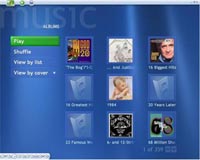
Media Center Music Interface
Music playback is very nice. MCE retreives the cover art and album information for both CDs and MP3s from the internet. The playlist interface is a bit clunky and non-intuitive, but functional. (The playlist functionality for the video player is notably absent.) Visualizations are the standard Windows Media Player fare.
I came across some simple add-ons for MCE. One allowed me to view my NetFlix queue, new relases, and most popular rentals. Another offered a simple weather display (nothing nearly as elegant and useful as the one featured in MythTV). I added QuickTime to my list of “Other Programs” so I could access the application from within Media Center. It operates independantly, minimizing Media Center during playback.
At this point, I was starting to lean towards MCE as my solution. I haven’t even tried Beyond TV. I wanted a solution that worked without unneccesary complication. MythTV was nice, but not yet a complete, consumer-ready solution. But, I haven’t even tried the TV functions for either solution yet. Would I change my mind or would I just loose it?
- Duane
December 7th, 2004:
Home Media Center Article Part 2 Available. Elitegeek.net coming soon.
I’ve posted part 2 (out of 4) of my home media center round-up. Check it out. Although I hoped to get updates out a few days apart, it looks like a week apart is more realistic. Blame school.
A few friends from work (Brad and Keith) and I are working on a geek review site. We’re hoping to cover hardware, software, phones, handheld gadgets, toys, etc. Elitegeek.net will be available in January of 2005.
- Duane
 Pictures
Pictures
